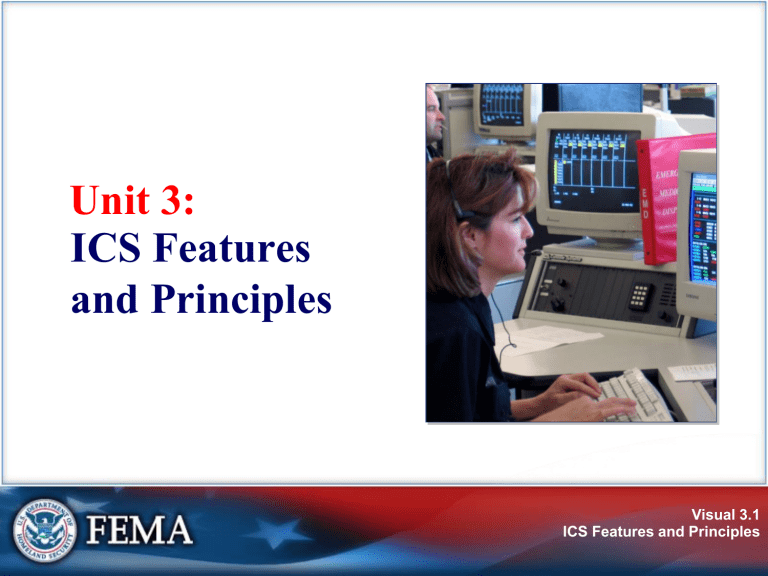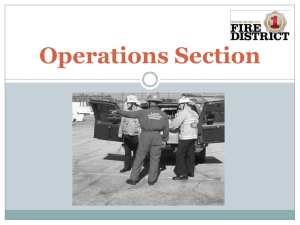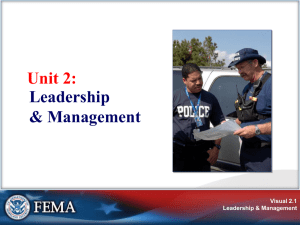03ICS100b_Visuals_October2013x

Unit 3:
ICS Features and Principles
Visual 3.1
ICS Features and Principles
Unit Objectives
Describe the basic features of ICS.
Select the correct terminology for ICS facilities.
Identify common tasks related to personal accountability.
Visual 3.2
ICS Features and Principles
Click on image to start the video.
Visual 3.3
ICS Features and Principles
ICS Features: Overview
Standardization
Common terminology
Command
Establishment and transfer of command
Chain of command and unity of command
Planning/Organizational
Structure
Management by objectives
Incident Action Plan (IAP)
Modular organization
Manageable span of control
Facilities and Resources
Comprehensive resource management
Incident locations and facilities
Communications/Information
Management
Integrated communications
Information and intelligence management
Professionalism
Accountability
Dispatch/Deployment
Visual 3.4
ICS Features and Principles
Common Terminology – No Codes!
Using common terminology helps define:
Organizational functions.
Incident facilities.
Resource descriptions.
Position titles.
Visual 3.5
ICS Features and Principles
Discussion Question
Why should you use plain English during an incident response?
Visual 3.6
ICS Features and Principles
Why Plain English?
EMT = Emergency Medical Treatment
EMT = Emergency Medical Technician
EMT = Emergency Management Team
EMT = Eastern Mediterranean Time (GMT+0200)
EMT = Effective Methods Team
EMT = Effects Management Tool
EMT = El Monte, CA (airport code)
EMT = Electron Microscope Tomography
EMT = Email Money Transfer
Visual 3.7
ICS Features and Principles
ICS Features: Overview
Standardization
Common terminology
Command
Establishment and transfer of command
Chain of command and unity of command
Planning/Organizational
Structure
Management by objectives
Incident Action Plan (IAP)
Modular organization
Manageable span of control
Facilities and Resources
Comprehensive resource management
Incident locations and facilities
Communications/Information
Management
Integrated communications
Information and intelligence management
Professionalism
Accountability
Dispatch/Deployment
Visual 3.8
ICS Features and Principles
Command: Definition
Command : The act of directing, ordering, or controlling, by virtue of explicit statutory, regulatory, or delegated authority.
At an incident scene, the
Incident Commander has the authority to assume command!
Visual 3.9
ICS Features and Principles
Transfer of Command
Moves the responsibility for command from one
Incident Commander to another.
Must include a transfer of command briefing
(which may be oral, written, or both).
Visual 3.10
ICS Features and Principles
When Command Is Transferred
A more qualified Incident
Commander arrives.
A jurisdiction or agency is legally required to take command.
Incident complexity changes.
The current Incident
Commander needs to rest.
Visual 3.11
ICS Features and Principles
Discussion Question
What would you include in a transfer of command briefing?
Visual 3.12
ICS Features and Principles
Chain of Command
Chain of command:
Is an orderly line of authority within the response organization.
Allows incident managers to direct and control the actions of all personnel under their supervision.
Avoids confusion by requiring that orders flow from supervisors.
Does not prevent personnel from sharing information.
Visual 3.13
ICS Features and Principles
Unity of Command
Under unity of command, personnel:
Report to only one incident supervisor.
Receive work assignments only from the assigned supervisor.
Visual 3.14
ICS Features and Principles
Activity: Assuming Command
Instructions: Working as a team . . .
1. Review the scenario and the discussion question presented in the
Student Manual.
2. Choose a spokesperson to record your responses.
3. Be prepared to share your answers in
5 minutes.
Visual 3.15
ICS Features and Principles
ICS Features: Overview
Standardization
Common terminology
Command
Establishment and transfer of command
Chain of command and unity of command
Planning/Organizational
Structure
Management by objectives
Incident Action Plan (IAP)
Modular organization
Manageable span of control
Facilities and Resources
Comprehensive resource management
Incident locations and facilities
Communications/Information
Management
Integrated communications
Information and intelligence management
Professionalism
Accountability
Dispatch/Deployment
Visual 3.16
ICS Features and Principles
Management by Objectives
Priorities for incident objectives are:
#1: Life Safety
#2: Incident
Stabilization
#3: Property/
Environmental
Preservation
Visual 3.17
ICS Features and Principles
ICS Organization
Differs from day-to-day organizational structures and positions by:
Using unique ICS position titles and organizational structures.
Assigning personnel based on expertise, not rank. For example, a director may not hold that title when deployed under an ICS structure.
Visual 3.18
ICS Features and Principles
Modular Organization
Incident command organizational structure is based on:
Size, type, and complexity of the incident.
Specifics of the hazard environment created by the incident.
Incident planning process and incident objectives.
Visual 3.19
ICS Features and Principles
Incident Action Planning
Every incident must have an
Incident Action Plan (IAP) that:
Specifies the incident objectives.
States the activities.
Covers a specified timeframe, called an operational period.
May be oral or written .
Incident
Action
Plan
Visual 3.20
ICS Features and Principles
Elements of an Incident Action Plan
Every IAP must have four elements:
What do we want to do?
Who is responsible for doing it?
How do we communicate with each other?
What is the procedure if someone is injured?
Visual 3.21
ICS Features and Principles
Activity: Incident Action Plan
Instructions: Working as a team . . .
1. Identify four items you would include in an IAP for the severe weather scenario in Unit 2.
2. Write these items on chart paper.
3. Select a spokesperson. Be prepared to present in 5 minutes.
Visual 3.22
ICS Features and Principles
Manageable Span of Control
Span of control:
Pertains to the number of individuals or resources that one supervisor can manage effectively during an incident.
Is key to effective and efficient incident management.
Resource 1
Supervisor
Resource 3
Resource 2
Visual 3.23
ICS Features and Principles
ICS Management: Span of Control
ICS span of control for any supervisor:
Is between 3 and 7 subordinates.
Optimally does not exceed 5 subordinates.
Visual 3.24
ICS Features and Principles
Activity: Span of Control
Instructions: Working individually . . .
1. Review the scenario and answer the question presented in the Student Manual.
2. Be prepared to share your answer in 5 minutes.
Incident Command
Resource Resource Resource Resource
Resource Resource Resource Resource
Visual 3.25
ICS Features and Principles
ICS Features: Overview
Standardization
Common terminology
Command
Establishment and transfer of command
Chain of command and unity of command
Planning/Organizational
Structure
Management by objectives
Incident Action Plan (IAP)
Modular organization
Manageable span of control
Facilities and Resources
Comprehensive resource management
Incident locations and facilities
Communications/Information
Management
Integrated communications
Information and intelligence management
Professionalism
Accountability
Dispatch/Deployment
Visual 3.26
ICS Features and Principles
Click on image to start the video.
Visual 3.27
ICS Features and Principles
Incident Facility Map Symbols
Incident
Command
Post
Staging
Area
Base Camp,
Helibase, and Helispot
Visual 3.28
ICS Features and Principles
Incident Facilities: Summary
A single Incident Command Post should be established on all incidents —even small ones!
Incidents may require additional facilities
(e.g., a call center).
Areas may be predesignated incident facilities for the surrounding community
(e.g., shelters, staging areas, helibases, medical centers).
Visual 3.29
ICS Features and Principles
Resources: Definition
Resources are personnel and major items of equipment, supplies, and facilities available or potentially available for assignment to incident operations and for which status is maintained.
Visual 3.30
ICS Features and Principles
Resource Management
Resource management includes processes for:
Categorizing resources.
Ordering resources.
Dispatching resources.
Tracking resources.
Recovering resources.
Reimbursing other organizations.
Visual 3.31
ICS Features and Principles
Activity: Staging Areas
Instructions: Working as a team . . .
1. Review the scenario and discussion question presented in the Student
Manual.
2. Select a spokesperson. Be prepared to share your answer in 5 minutes.
Visual 3.32
ICS Features and Principles
ICS Features: Overview
Standardization
Common terminology
Command
Establishment and transfer of command
Chain of command and unity of command
Planning/Organizational
Structure
Management by objectives
Incident Action Plan (IAP)
Modular organization
Manageable span of control
Facilities and Resources
Comprehensive resource management
Incident locations and facilities
Communications/
Information Management
Integrated communications
Information and intelligence management
Professionalism
Accountability
Dispatch/Deployment
Visual 3.33
ICS Features and Principles
Integrated Communications
Incident communications are facilitated through:
The development and use of a common communications plan.
The interoperability of communication equipment, procedures, and systems.
Before an incident, it is critical to develop an integrated voice and data communications system (equipment, systems, and protocols).
Visual 3.34
ICS Features and Principles
Discussion Question
What are some examples of information and intelligence used to manage an incident?
Visual 3.35
ICS Features and Principles
Activity: Information Management
Instructions: Working as a team . . .
1. Review the scenario presented in the
Student Manual.
2. Discuss the implications for incident management, and record your answers on chart paper.
3. Select a team spokesperson and be prepared to share your answers in 5 minutes.
Visual 3.36
ICS Features and Principles
ICS Features: Overview
Standardization
Common terminology
Command
Establishment and transfer of command
Chain of command and unity of command
Planning/Organizational
Structure
Management by objectives
Incident Action Plan (IAP)
Modular organization
Manageable span of control
Facilities and Resources
Comprehensive resource management
Incident locations and facilities
Communications/Information
Management
Integrated communications
Information and intelligence management
Professionalism
Accountability
Dispatch/Deployment
Visual 3.37
ICS Features and Principles
Accountability (1 of 2)
Check-In.
All responders must report in to receive an assignment in accordance with the procedures established by the Incident
Commander.
Incident Action Plan.
Response operations must be coordinated as outlined in the IAP.
Unity of Command.
Each individual will be assigned to only one supervisor.
Visual 3.38
ICS Features and Principles
Accountability (2 of 2)
Span of Control.
Supervisors must be able to adequately supervise and control their subordinates, as well as communicate with and manage all resources under their supervision.
Resource Tracking.
Supervisors must record and report resource status changes as they occur.
Visual 3.39
ICS Features and Principles
Dispatch/Deployment
At any incident:
The situation must be assessed and the response planned.
Managing resources safely and effectively is the most important consideration.
Personnel and equipment should respond only when requested or when dispatched by an appropriate authority.
Visual 3.40
ICS Features and Principles
Discussion Question
Why shouldn’t personnel arrive at an incident without being requested or dispatched?
Visual 3.41
ICS Features and Principles
Activity: Deployment
Instructions: Working individually . . .
1. Review the scenario and answer the question presented in the Student
Manual.
2. Be prepared to share your answer in 5 minutes.
Visual 3.42
ICS Features and Principles
Summary (1 of 2)
ICS:
Utilizes management features including the use of common terminology and a modular organizational structure.
Emphasizes effective planning through the use of management by objectives and
Incident Action Plans.
Supports responders by providing data they need through effective information and intelligence management.
Visual 3.43
ICS Features and Principles
Summary (2 of 2)
ICS:
Utilizes the principles of chain of command, unity of command, and transfer of command.
Ensures full utilization of incident resources by maintaining a manageable span of control, establishing predesignated incident facilities, implementing resource management practices, and ensuring integrated communications.
Visual 3.44
ICS Features and Principles







